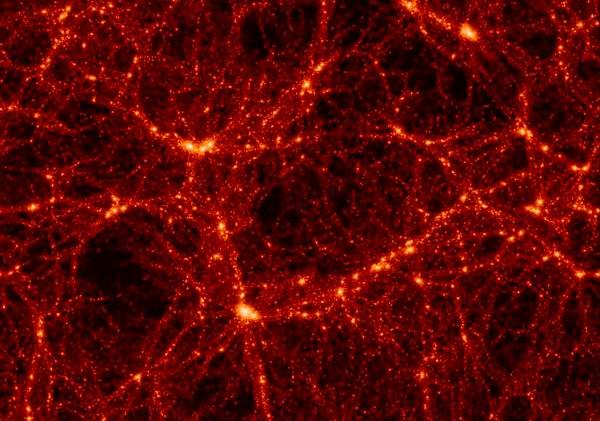Since the mid-20th century, scientists have had a pretty good idea of how the Universe came to be. Cosmic expansion and the discovery of the Cosmic Microwave Background (CMB) lent credibility to the Big Bang Theory, and the accelerating rate of expansion led to theories about Dark Energy. Still, there is much about the early Universe that scientists still don’t know, which requires that they rely on simulations on cosmic evolution.
This has traditionally posed a bit of a problem since the limitations of computing meant that simulation could either be large scale or detailed, but not both. However, a team of scientists from Germany and the United States recently completed the most detailed large-scale simulation to date. Known as TNG50, this state-of-the-art simulation will allow researchers to study how the cosmos evolved in both detail and a large scale.
TNG50 is the latest simulation produced by IllustrisTNG, an ongoing project dedicated to the creation of large, cosmological simulations of galaxy formation. It is groundbreaking in that it avoids the traditional trade-off astronomers are forced to contend with. In short, detailed simulations suffered from low-volume in the past, which made statistical deductions about large-scale cosmic evolution difficult.
Large-volume simulations, on the other hand, traditionally lack the detail to reproduce many of the small-scale properties that of the Universe, which makes their predictions less reliable. The TNG50 is the first simulation of its kind in that it manages to combine the idea of large-scale simulations – the “Universe in a box” concept – with the kind of resolution that was previously only possible with galaxy simulations.
This was made possible by the Hazel Hen supercomputer in Stuttgart, where 16,000 cores worked together for more than a year – the longest and most resource-intensive simulation to date. The simulation itself consists of a cube of space measuring more than 230 million light-years in diameter that contains more than 20 billion particles representing dark matter, stars, cosmic gas, magnetic fields, and supermassive black holes (SMBHs).
TNG50 can also discern physical phenomena that occur on scales down to one one-millionth of the overall volume (i.e. 230 light-years). This allows the simulation to trace the simultaneous evolution of thousands of galaxies over the course of 13.8 billion years of cosmic history. The results of their simulation were published in two papers that recently appeared in the journal Monthly Notices of the Royal Astronomical Society.
Both studies were led by Dr. Annalisa Pillepich of the Max Planck Institute for Astronomy, and Dr. Dylan Nelson of the Max Planck Institute for Astrophysics. As Dylan explained in a RAS press release:
“Numerical experiments of this kind are particularly successful when you get out more than you put in. In our simulation, we see phenomena that had not been programmed explicitly into the simulation code. These phenomena emerge in a natural fashion, from the complex interplay of the basic physical ingredients of our model universe.”

In addition, TNG50 is the first simulation of its kind to two emergent phenomena that play a key role in the evolution of galaxies. First, the research team noticed that as they looked back in time, that orderly, rapidly-rotating disc galaxies (like the Milky Way) emerged from initially chaotic clouds of gas.
As this gas settled, newborn stars adopted increasingly circular orbits, eventually giving way to large spiral galaxies. As Dr. Annalisa Pillepich explained:
“In practice, TNG50 shows that our own Milky Way galaxy with its thin disc is at the height of galaxy fashion: over the past 10 billion years, at least those galaxies that are still forming new stars have become more and more disc-like, and their chaotic internal motions have decreased considerably. The Universe was much messier when it was just a few billion years old!”
The second emergent phenomenon appeared as the galaxies flatten out in the simulation, where high-speed winds of gas were seen flowing out of galaxies. This was driven by supernovae explosions and activity from SMBHs at the heart of the simulated galaxies. Once again, the process was initially chaotic with gas flowing out in all directions, but eventually becoming more focused along a path of least resistance.

By the current cosmological epoch, these flows become cone-shaped and flow from the opposite ends of the galaxy, with the material slowing down as it leaves the invisible gravity well of the galaxy’s dark matter halo. Eventually, this material stops flowing outwards and begins to fall back in, effectively becoming a galactic fountain of recycled gas.
In other words, this simulation is also the first of its kind to show how the geometry of cosmic gas flows around galaxies determines their structures (and vice versa). For their work, Dr. Pillepich and Dr. Nelson were awarded the 2019 Golden Spike Award, which is issued to members of the international research community by the High-Performance Computer Center in Stuttgart, Germany.
Dr. Pillepich and Dr. Nelson and their colleagues also plant to eventually release all the TNG50 simulation data to the astronomical community and to the public. This will allow astronomers and citizen scientists to make their own discoveries from the simulation, which could include additional examples of emergent cosmic phenomena or resolutions to enduring cosmic mysteries.
Further Reading: Royal Astronomical Society, MNRAS, MNRAS (2)


Thanks, haven’t seen this elsewhere! LCDM has come a long way.